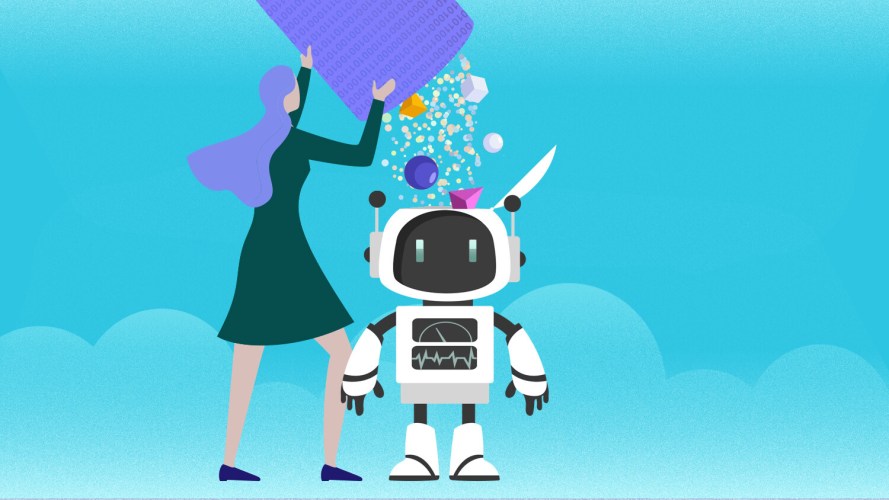Why Purpose-Built Agents are the Future of AI at Work

Purpose-built agents are focused on one specific job. And they boast a superpower most GPT-based tools can’t match: they take action and get real work done.
We’re witnessing a pivotal shift in artificial intelligence, where the sweeping scale of huge, all-purpose AI is giving way to the precision and finesse of purpose-built autonomous agents. This is not just a technical advancement. It’s a reimagining of how machines can augment a worker’s potential.
Whether that’s helping sales reps nurture leads, brainstorming campaign ideas for product marketers, or deflecting customer service calls, these purpose-built agents are focused on one specific job, and doing it exceedingly well. Even better, they boast a superpower most GPT-based tools can’t match: the ability to take action and get real work done.
“LLMs are extremely powerful, but they are part of a much more complex and nuanced AI architecture,” said Itai Asseo, senior director of incubation and brand strategy, AI research at Salesforce. “Sometimes you need a big multipurpose LLM, but in many cases a specialized agent will be a much more efficient solution.”
Business leaders clearly see the potential. A Capgemini survey found 82% of large companies plan to implement agents by 2027, heralding a new way of working that demands a new technological approach.
Autonomous agents will revolutionize work
If you’ve ever used generative AI to help draft an email or brainstorm a campaign idea, you’ve probably been impressed by the technology’s potential, while simultaneously feeling frustrated by some of the hard limitations of GPT-based tools in the workplace.
They’re trained on “general” data, so they don’t know your business or customers, and can’t generate outputs that reflect your day-to-day reality. They can’t tell you, for example, about open sales opportunities or provide year-to-date campaign performance.
Forward-thinking organizations are already beginning to bridge that knowledge shortfall with an innovative new type of data platform that aggregates and harmonizes data, and connects the dots between every data point. But for AI to truly be effective in an enterprise setting, a second requirement must be met: it needs to have the ability to take action on your behalf.
Agents deliver this capability by combining the language and reasoning powers of LLMs with large action models (LAMs). A LAM is a type of language model that specializes in “function-calling,” which is the ability to execute actions in other systems and apps. LAMs are trained on datasets specifically curated for performing tasks, enabling agents to autonomously trigger a wide range of actions.
“Large action models are ideal for agentic AI systems because they are specifically designed to take action by invoking functions directly in applications. This opens up a world of possibilities for autonomous applications,” said Asseo. “Salesforce’s xLAM, a family of large action models designed for AI agent systems, breaks down each portion of a request, mining several different places to find the data it needs and to take action.”
LLMs and LAMs: the backbone of autonomous AI
How do LLMs and LAMs work together? Imagine asking an AI agent to send a personalized email to the first 100 people who purchase a new product, with a discount for future orders.
On its own, an LLM would be hard pressed to pull this off. Sure, it could generate the copy, but segmenting 100 buyers and sending each a personalized message requires action: That’s where the LAM takes over. Through its function-calling capabilities, the LAM would send requests to execute individual tasks, whether that’s a call to an internal database to pull customer and product information, or an API call to an external system.
“Trying to get an LLM to do the same thing would involve a lot of prompting and engineering work,” said Asseo.
In healthcare, an agent could help patients identify the right doctor based on their symptoms, needs and location. It finds an available time and books the appointment, streamlining what’s often a frustrating and time-consuming process.
In retail, an agent could handle simple queries like “where’s my package?” as well as deliver highly targeted sales recommendations, customer service, or marketing promotions exactly when the customer is most receptive.
In financial services, an agent could analyze a client’s spending habits, investment history, and financial goals to suggest adjustments to their investment portfolio, factoring in risk tolerance and potential returns. This saves investment managers time analyzing data, allowing them to focus on delivering high-value client service.
Organizations that lead with AI agents can greatly expand the capabilities of their workforce. Imagine zero hold queues for service calls, websites that update themselves based on user engagement, and agentic sales coaches who never tire of helping salespeople close deals.
Autonomous agents work alongside you
We’re rapidly approaching a future where employees work with agents to deliver better outcomes for businesses and customers alike. These systems promise to boost efficiency and free humans to focus on innovation and creation.
With AI managing the details, individuals can delve into complex problem-solving and strategic thinking, pushing the boundaries of what’s possible and sparking breakthroughs across various fields. This partnership between human ingenuity and AI marks a new era of productivity, efficiency, and creative potential.
Imagine a workforce with no limits
You can transform the way work gets done across every role, workflow, and industry. Learn how to build and customize autonomous AI agents to support your employees and customers.
































